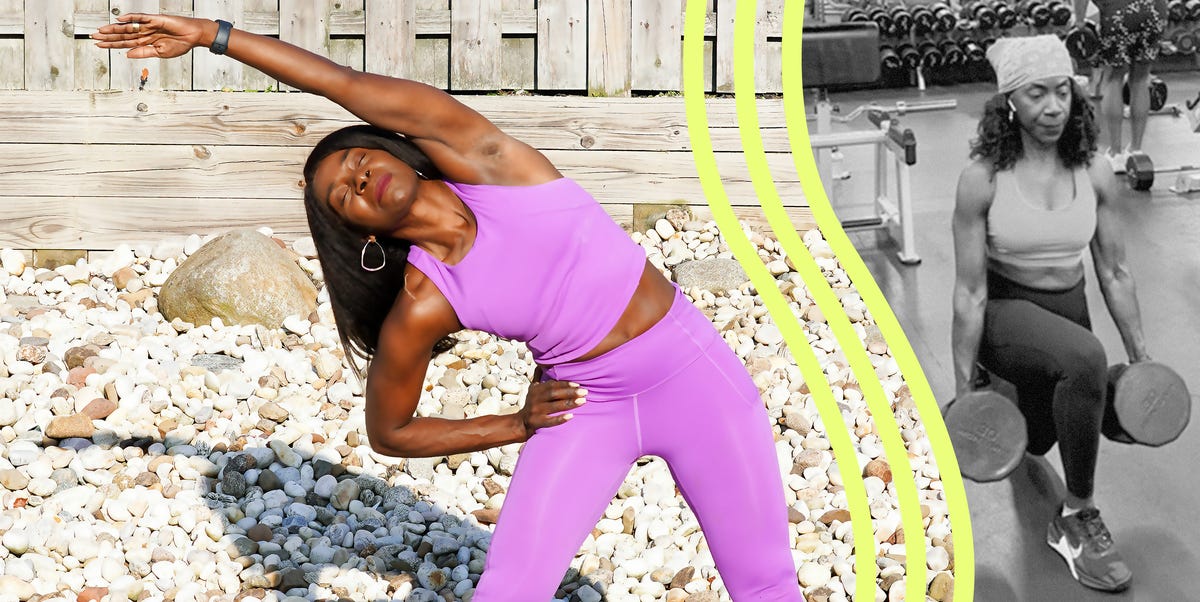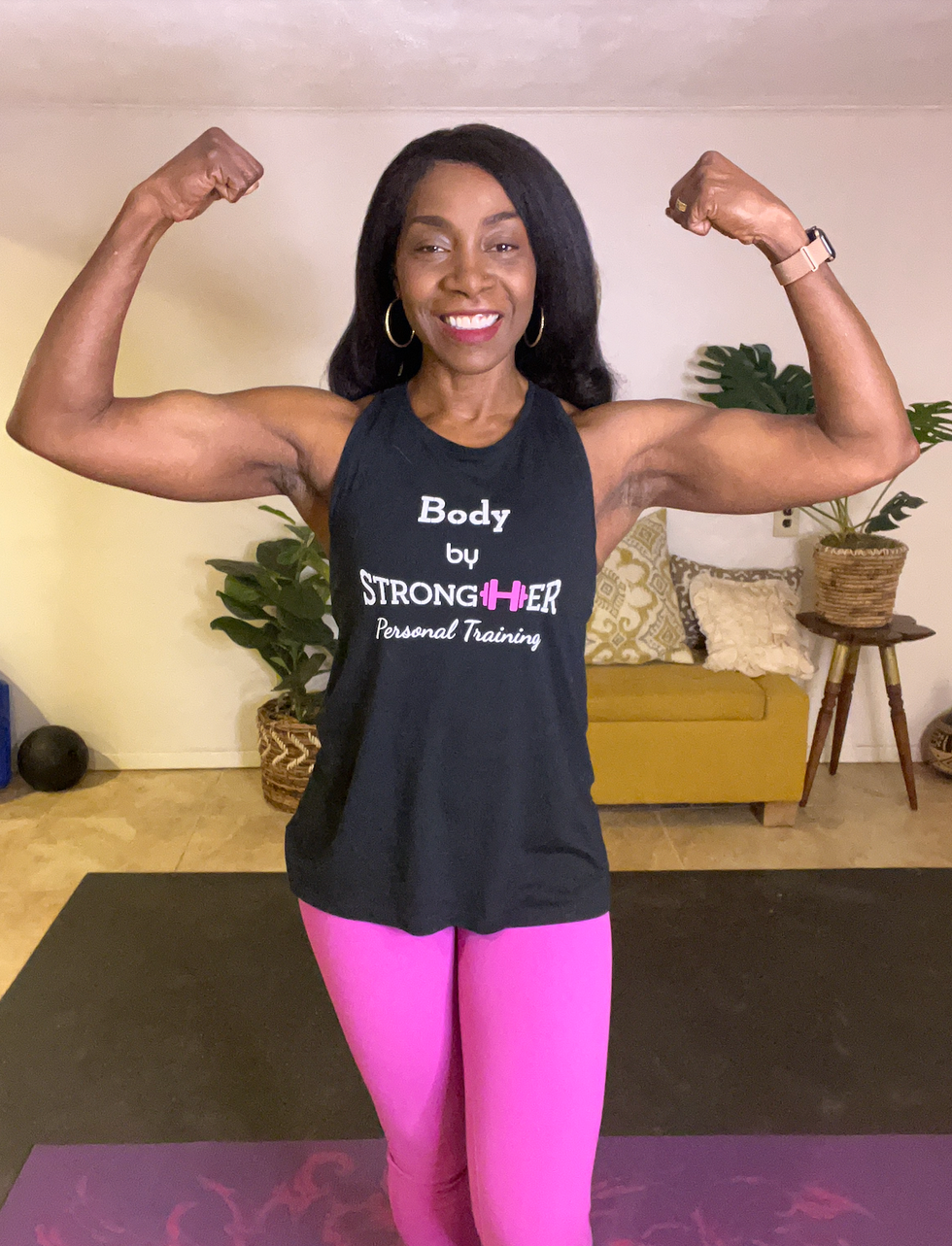Patricia Greaves, CPT, is a class of 2022 WH Strength in Diversity trainer and the founder of StrongHer Personal Training, a virtual and in-person coaching service.
Consistent strength training kept me fit through my pregnancies, but a few years after I had my third daughter at age 36, I started not feeling like myself. Around that time, I began experiencing symptoms of early perimenopause, which made it even harder to feel confident in my body despite my efforts. I decided it was time to reinvest in myself, and made a goal to be more intentional with my fitness routine.
I’ve always loved the feeling of being strong, and was instantly hooked on lifting when I first tried it. One summer in high school, my older cousin took me to a gym where we did a strength training circuit class using all these different weight machines. When I wasn’t studying in college, I was working out. I felt at home in the gym, weight training with the guys.
When I got married and started having kids at 30, I kept up with my workout routine. It wasn’t as regimented as in my pre-mom life, but I still went to the gym two or three times a week.
From losing baby weight to managing perimenopause, fitness transformed much more than my physical body.
After my last pregnancy, I began experiencing intense anxiety, which I later learned was a symptom of early perimenopause. Even though I was still in my 30s, I suffered from terrible hot flashes, panic attacks, and heart palpitations—symptoms I didn’t realize could be linked to perimenopause. On two occasions, I called an ambulance, fearing I was having a heart attack due to the chest pain.
Around the same time, my father became very ill, and I was managing his care. The gym became my refuge—a place where I could ground myself and manage the stress in my life. Getting back into the gym with more consistency started as a way to lose baby weight, but ended up positively impacting many aspects of my life.
A few years into my consistent gym routine, a local trainer encouraged me to compete in a bodybuilding competition. I agreed to register for the competition and train together, and entered my first competition in 2010, placing third against women half my age. Since then, I’ve competed seven more times and earned my pro card in 2018. (FYI: A bodybuilding pro card is a certification that allows athletes to compete in pro-level competitions for money and sponsorships.) I competed as a pro for the first time in 2019, with the support of my family. My husband helped with my cardio and posing routines, while my three daughters cheered me on, telling me how great I looked. It’s empowering to think of myself as the nerdy girl with the coke-bottle glasses I once was, and then see myself on stage in a tiny bikini, proudly flexing my muscles. I plan to compete again in three years, when I turn 60.
Earning my pro card inspired me to help other women.
After earning my pro card, I knew I wanted to take things further by helping women over 40 realize that building muscle is empowering and nothing to shy away from. While I loved bodybuilding, I felt I had accomplished what I set out to do by earning my pro card, so I decided to become a personal trainer. I completed my certification course and began taking on clients in my spare time. By 2018, I formed my own business, operating mostly online and running fitness camps during the summer. My mantra for my clients is ‘we can do hard things.’ In addition to my fitness work, I’ve been a teacher for over 27 years, and strive to empower my middle schoolers through promoting self-confidence, healthy habits, and leadership.
My weekly workout routine is pretty consistent these days.
I train at the gym three or four times a week on average and take a pilates class one evening each week. I split my strength training into lower body and upper body/core days, focusing on about three to five different exercises per session, with four sets per exercise. I start with a warm-up set using light weights for 10 reps, then progressively add weight and decrease reps with each set (this is called pyramid training). I stop increasing the weight once I notice my form starting to slip, which tells me I’ve hit my max. My goal is to add around five to 10 pounds with each set, depending on the exercise. (It tends to be easier to increase weight for lower body moves compared to upper body moves since the muscles are larger and can handle more resistance.)
In my experience, every woman can benefit from investing in at least three pairs of dumbbells—a set of light, medium and heavy (for you). (To minimize equipment and save space, you can even opt for a single pair of adjustable dumbbells!)
- Light set: choose something that feels challenging by rep 10
- Medium set: choose something that feels challenging by rep eight
- Heavy set: choose something that you can work toward, which can feel challenging by reps four to six, depending on your comfort level and goals
It’s important to have a range of weights to work with regularly because as you gain strength over time, your muscles require more resistance to avoid plateaus. A lot of women get stuck and don’t see progression by lifting the same weight for weeks, months, or even years. If you’re strength training regularly, try leveling up more frequently to continue giving your muscles the stimulus they need to get stronger.
Here’s what a typical week of workouts looks like for me:
Monday: Lower body
Tuesday: Rest day
Wednesday: Upper body
- Bent-Over Row (3 sets: 12, 10, 8 reps)
- Pullup (2 sets: 5 reps or to failure)
- Chinup (2 sets: 5 reps or to failure)
- Lat pulldown machine (3 sets: 12, 10, 8 reps)
- Single-arm row (3 sets: 12, 10, 8 reps)
Thursday: Pilates class
Friday: Rest day
Saturday: Lower body (4 sets: 12, 10, 8, 6 reps or to failure)
Sunday: 5k run
These four things were key to my strength transformation success
- Following a structured program: It’s easy to get overwhelmed by all the exercises you see people doing on social media, but having a structured plan tailored to your goals is crucial to progress. Your program should be gradually more challenging, starting at your current level and building from there. Consistency is more important than excitement, so don’t feel the need to switch up your exercises super often. If you’re new to the gym, consider finding a trainer to help you understand the machines and learn proper form for free weight exercises to avoid injury and get the most out of your sessions.
- Eliminating distractions: When it’s time for your workout, commit fully—put your phone away and stay focused. This is your time. Engaging your muscles effectively requires focus and mind-muscle connection, so don’t rush through the exercises. You don’t need to spend an hour in the gym; even a short, consistent 20-minute workout can be effective if you do it consistently and with intention.
- Shifting the focus beyond aesthetics: The goal isn’t just about how you look; it’s about improving health, longevity, and staying vibrant through aging. It’s about adding more life to your life, not about shedding pounds. Strength training can help maintain independence for years to come.
- Prioritizing nutrition: When I started bodybuilding, I began prioritizing protein and cooking at home more. I pay attention to nutrients like calcium for bone density, eat plenty of greens like kale and spinach, and don’t count calories, but I’m mindful of portion sizes—keeping starches to a small handful and aiming for 100 to 120 grams of protein throughout each day. On days I’m planning to lift heavy, I fuel up with healthy carbs to sustain my energy, like steel-cut oatmeal or protein pancakes. After workouts, I always make sure to eat protein.
Read the full article here





